Seraphim of Sarov
Seraphim of Sarov (Russian: Серафим Саровский) (30 July [O.S. 19 July] 1754 (or 1759) – 15 January [O.S. 2 January] 1833), born Prokhor Moshnin (Прохор Мошнин), is one of the most renowned Russian saints and venerated both in the Eastern Orthodox Church and the Catholic Church. He is generally considered the greatest of the 19th-century startsy (elders). Seraphim extended the monastic teachings of contemplation, theoria and self-denial to the layperson. He taught that the purpose of the Christian life was to acquire the Holy Spirit. Perhaps his most popular quotation amongst Orthodox believers is "Acquire a peaceful spirit, and thousands around you will be saved."
Seraphim of Sarov | |
|---|---|
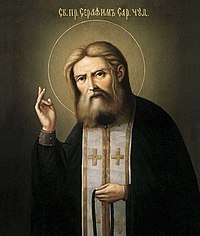 Icon of Saint Seraphim of Sarov | |
| Confessor, Wonderworker | |
| Born | 30 July 1754 Kursk, Russian Empire |
| Died | 15 January 1833 (aged 78) Sarov, Russian Empire |
| Venerated in |
|
| Canonized | 19 July 1903 (O.S.), Sarov Monastery by Holy Governing Synod, Russian Orthodox Church |
| Major shrine | Diveevo Convent, Russia |
| Feast |
|
| Attributes | Wearing peasant clothing, often kneeling with his hands upraised in prayer; crucifix worn about his neck; hands crossed over chest |
| Patronage | Russia's Nuclear Weapons |
Seraphim was canonized by the Russian Orthodox Church in 1903. Alongside his veneration in the Catholic calendar, Pope John Paul II also referred to him as a Saint.[1]
Life

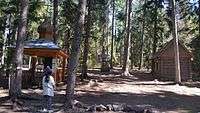
Born 19 July (O.S.) 1754, the future saint was baptized with the name of Prochor, after Prochorus, one of the first Seven Deacons of the Early Church and the disciple of John the Evangelist. His parents, Isidore and Agathia Moshnin, lived in Kursk, Russia. His father was a merchant. According to Orthodox Church tradition, a wonderworking icon of the Theotokos (Virgin Mary), Our Lady of Kursk, healed the young boy. Seraphim later experienced a number of visions.
In 1775, at the age of 17, he visited Dorothea of Kiev.
In 1777, at the age of 19, he joined the Sarov monastery as a novice (poslushnik). He was officially tonsured (took his monastic vows) in 1786 and given the religious name of Seraphim (which means "fiery" or "burning" in Hebrew). Shortly afterwards, he was ordained a hierodeacon (monastic deacon). In 1793, he was ordained as a hieromonk (monastic priest) and became the spiritual leader of the Diveyevo Convent, which has since come to be known as the Seraphim-Diveyevo Convent.
Soon after this, Seraphim retreated to a log cabin in the woods outside Sarov monastery and led a solitary lifestyle as a hermit for 25 years. During this time his feet became swollen to the point that he had trouble walking. Sarov's eating and fasting habits became more strict.[2] At first he ate bread obtained from the monastery and vegetables from his garden, then only vegetables. For three years, he ate only grass.[2]
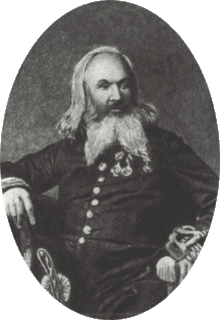
One day, while chopping wood, Seraphim was attacked by a gang of thieves who beat him mercilessly with the handle of his own axe. He never resisted, and was left for dead. The robbers never found the money they sought, only an icon of the Theotokos (Virgin Mary) in his hut. Seraphim had a hunched back for the rest of his life. However, at the thieves' trial he pleaded to the judge for mercy on their behalf.
"After this incident, Seraphim spent 5 months in the monastery, recovering, and there again returned to the desert, for the former spiritual feats." ("Святый преподобный Серафим Саровский чудотворец" – стр. 14)
After this incident Seraphim spent 1,000 successive nights on a rock in continuous prayer with his arms raised to the sky, a feat of asceticism deemed miraculous by the Eastern Orthodox Church, especially considering the pain from his injuries.
In 1815, in obedience to a reputed spiritual experience that he attributed to the Virgin Mary, Seraphim began admitting pilgrims to his hermitage as a confessor. He soon became immensely popular due to his reputation for healing powers and gift of prophecy. Hundreds of pilgrims per day visited him, drawn as well by his ability to answer his guests' questions before they could ask.
As extraordinarily harsh as Seraphim often was to himself, he was kind and gentle toward others — always greeting his guests with a prostration, a kiss, and exclaiming "Christ is risen!", and calling everyone "My joy." He died while kneeling before an Umilenie icon of the Theotokos which he called "Joy of all Joys". This icon is kept currently in the chapel of the residence of the Patriarch of Moscow.
Relics, canonization and veneration

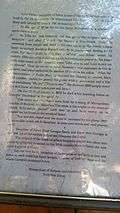

There was a widespread popular belief in Russia that a saint's remains were supposed to be incorrupt, which was not the case with Seraphim as was officially ascertained by a commission that researched his grave in January 1903. This, however, did not deter canonisation, spearheaded by archimandrite Seraphim Chichagov as well as popular veneration.[3] At the end of January (O.S.) 1903, the Most Holy Synod, having received approval from Emperor Nicholas II, announced Seraphim's forthcoming glorification.[4] In early July 1903, his relics were transferred from their original burial place to the church of Saints Zosimus and Sabbatius. Nicholas II and Tsarina Alexandra provided a new cypress coffin to receive the relics. The solemn canonisation (discovery of the relics) festivities took place in Sarov on 19 July (1 August) 1903 and were attended by the Tsar, his wife, his mother Empress Maria Feodorovna, and other senior members of the Imperial Family.[5][6]
On 18 July 1903, Metropolitan Anthony Vadkovsky of St. Petersburg officiated at the Last Pannikhida (Memorial Service) in the Dormition Cathedral at Sarov, with the royal family in attendance. These would be the last prayers offered for Seraphim as a departed servant of God; from that time forward, prayers would instead be addressed to him as a saint. On 19 July, Seraphim's birthday, the late liturgy began at 8 o'clock. At the Little Entrance, twelve archimandrites lifted the coffin from the middle of the church and carried it around the Holy Table (altar), then placed it into a special shrine which had been constructed for them.
The festivities at Sarov ended with the consecration of the first two churches dedicated to St. Seraphim. The first had been constructed over his monastic cell in the wilderness of Sarov. The second church was consecrated on 22 July at the Diveyevo convent.
Following the Bolshevik Revolution, Soviet authorities severely persecuted religious groups. As part of their persecution of Christians, they confiscated many relics of saints, including St. Seraphim. Furthermore, his biographer Seraphim Chichagov, who came to become a Metropolitan, was arrested, sentenced to death and executed by firing squad in 1937 (and is also celebrated as a Russian Orthodox saint).
In 1991, St. Seraphim's relics were rediscovered after being hidden in a Soviet anti-religious museum for seventy years. This caused a sensation in post-Soviet Russia and throughout the Orthodox world. A crucession (religious procession) escorted the relics, on foot, all the way from Moscow to Diveyevo Convent, where they remain to this day.
On 19 October 2016, relics of Seraphim were launched into space aboard the Soyuz MS-02.[7]
Seraphim is a patron saint of Russia's nuclear weapons.[8]
Quotes
"Acquire a peaceful spirit, and around you thousands will be saved."
"It is necessary that the Holy Spirit enter our heart. Everything good that we do, that we do for Christ, is given to us by the Holy Spirit, but prayer most of all, which is always available to us."[9]
Seraphim and Old Believers

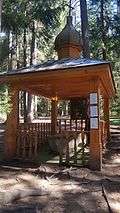
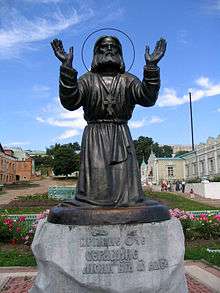
The available information about relations between Seraphim of Sarov and Russian Old Believers tradition is somewhat contradictory. On the one hand, in all the memoirs and biographies, and in the collections of his sayings, he is undoubtedly portrayed as a convinced supporter of the reforms in the Church and the official hierarchy.[10] On the other hand, on icons of St. Seraphim he is usually depicted with a lestovka in his left hand,[11] and in some cases even in old Russian, Old-Believers-style monastic garments (with a peculiar klobuk, and an old-fashioned cast bronze cross), as it is with these objects that he is depicted on the only lifetime portrait of him.[12] The lestovka used by St. Seraphim is preserved up to this time among his personal belongings.[13]
According to some sources, the known problems with the beatification of Seraphim of Sarov did happen exactly due to his general support and sympathy towards the Old Believers tradition,[14][15] in which case the negative assessment of the old rite, ascribed to him, would have been interpreted as inventions of his followers, who tried to put their teacher in the most favorable light in the eyes of the official church functionaries.[16] It was also suggested that St. Seraphim could have descended from a family of Old Ritualists,[14] or from a family of secret, cryptic Old Believers (that were widespread in northern and eastern areas of Russia),[12] possibly with consequent gradual shift towards edinoverie.[13]
In spite of some (alleged) controversy, St. Seraphim was known, at least at the level of official hagiography, for his rejection of the Russian old rites.[17] The majority of old believers authors doubt virtually all the facts known about St. Seraphim, as well as the very legitimacy of his beatification,[18][19] and his name is invariably used in interdenominational polemics.[12]
See also
- Hesychasm
- Diveevo convent
- Saint Seraphim of Sarov Church in Turnaevo
- Serafimovskoe Cemetery
- Thaumaturgy
- Tabor light
| Wikiquote has quotations related to: Seraphim of Sarov |
References
- Pope John Paul II, Crossing the Threshold of Hope, (Knopf, 1995), ISBN 978-0-679-76561-5, page 18.
- Johnston, William M. (2000). Encyclopedia of Monasticism. Fitzroy Dearborn Publishers. p. 1146. ISBN 978-1-57958-090-2
- A manual for Russian clergy published in Kiev in 1913 had a special detailed explanation for this case that stressed that incorruptibility of a saint′s remains was not a sine qua non: ″Некоторые утверждают, будто мощи святых всегда и непременно суть совершенно нетленные, то есть совершенно целые, нисколько неразрушенные и неповрежденные тела. Но понимание слова „мощи“ непременно в смысле целого тела, а не частей его и преимущественно костей, — неправильно, и вводит в разногласие с греческой церковию, так как у греков вовсе не проповедуется учения, что мощи означают целое тело, и мощи наибольшей части святых в Греции и на Востоке (равно как и на Западе) суть кости. Самое нетление мощей всецерковным сознанием не считается общим непременным признаком для прославления святых угодников. История прославления святых показывает, что некоторые из чтимых нами святых были прославлены до открытия их мощей, некоторые прославлены спустя то или другое время и даже очень значительное время после открытия их мощей; мощи довольно многих прославленных святых никогда не были открываемы. Мощи многих святых и в настоящее время находятся под спудом: в большей части случаев это значит, что мощи совсем не были открываемы, в меньшей части значит, что были открываемы, но потом опять закрыты. Мощи святых, когда они нетленны, составляют чудо, но лишь дополнительное к тем чудесам, которые творятся чрез их посредство. Доказательство святости святых составляют те чудеса, которые творятся при их гробах, или от их мощей, а мощи, целые тела или только кости, суть дарованные нам, для поддержания в нас живейшего памятования о небесных молитвенниках за нас, священные и святые останки некоторых святых, которых мы должны чтить, как таковые, и суть те земные посредства, чрез которые Господь наиболее прославляет Свою чудодейственную силу.″ (С. В. Булгаков. Настольная книга для священно-церковно-служителей. Kiev, 1913, р. 272 (footnote).)
- "Деяние Святейшаго Синода 29 января 1903 г. о канонизации преподобного Серафима Саровского". www.pravoslavie.ru. Retrieved 22 February 2018.
- "Саровские торжества 1903 года". www.ippo.ru. Retrieved 22 February 2018.
- "1 августа – обретение мощей преподобного Серафима, Саровского чудотворца / Статьи / Патриархия.ru". Патриархия.ru. Retrieved 22 February 2018.
- "Soyuz MS-02 spacecraft docking the International Space Station". Retrieved 22 February 2018.
- "Russian Orthodox Church considers ending blessings for nuclear weapons". Catholic Herald. Retrieved 7 August 2020.
- "Seraphim of Sarov – OrthodoxWiki". orthodoxwiki.org. Retrieved 22 February 2018.
- "Преподобный Серафим Саровский и старообрядцы" – an article at serafimushka.ru
- Iconography of St. Seraphim of Sarov at diveevo.ru (in Russian)
- Discussion at a religious history forum Archived 8 October 2011 at the Wayback Machine kuraev.ru
- Сергей Чесноков. От отступничества к единоверию Archived 13 January 2013 at Archive.today
- Кутузов Б.П. Церковная «реформа» XVII века. М., 2003.
- В.А. Степашкин. Преподобный Серафим Саровский: предания и факты
- Преподобный старообрядец Серафим Саровский – a chapter from a book of В.В. Смирнов "Падение III Рима"
- Православные святые об еретичестве старообрядцев – in a journal "Меч и трость. Православный монархический журнал"
- Никонианское «старчество» – Андрей Езеров, as published atstaropomor.ru
- В отсутствие святых – Павел де Рико, Александр Духов, as published at staropomor.ru
Further reading
- Dmitri Mereschkowski et al. Der letzte Heilige – Seraphim von Sarow und die russische Religiosität. Stuttgart 1994
- Archimandrite Lazarus Moore: St. Seraphim of Sarov – a Spiritual Biography. Blanco (Texas) 1994.
- Michaela-Josefa Hutt: Der heilige Seraphim von Sarow, Jestetten 2002, Miriam-Verlag, ISBN 978-3-87449-312-3
- Igor Smolitsch: Leben und Lehre der Starzen. Freiburg 2004
- Metropolit Seraphim: Die Ostkirche. Stuttgart 1950, pp. 282 ff.
- Paul Evdokimov: "Saint Seraphim of Sarow", in: The Ecumenical Review, April 1963
- Iwan Tschetwerikow: "Das Starzentum", in: Ev. Jahresbriefe; 1951/52, pp. 190 ff.
- Claire Louise Claus: "Die russischen Frauenklöster um die Wende des 18. Jahrhunderts", in: Kirche im Osten, Band IV, 1961.
- Bezirksrichter Nikolai Alexandrowitsch Motowilow: Die Unterweisungen des Seraphim von Sarow. Sergijew Possad 1914 (in Russian)
- Bishop Alexander (Mileant), "Saint Seraphim of Sarov", Orthodoxy and the world, December 2007.
External links
| Wikimedia Commons has media related to Seraphim of Sarov. |
- Quotes by St. Seraphim of Sarov at Orthodox Church Quotes
- St. Seraphim article on OrthodoxWiki
- St. Seraphim of Sarov life, writings and icons on Kursk Root (Korennaya) Icon Hermitage of the Birth of the Holy Theotokos site
- On the Acquisition of the Holy Spirit Spiritual conversation of Saint Seraphim
- A wonderful revelation to the world, www.stseraphim.org
- Uncovering of the relics of the Venerable Seraphim of Sarov Orthodox icon and synaxarion
- Glorification of Saint Seraphim. Sarov, 1903
- Photos of St. Seraphim glorification solemnity in Sarov (1903), Martha and Mary Convent site
- Photos of St. Seraphim glorification in Sarov (high res images), sarov.net
- St. Seraphim's biography by Archimandrite Nektarios Serfes
- Portal devoted to 100-th anniversary of St. Seraphim of Sarov glorification (in Russian)
- English page on Sarov monastery web-site